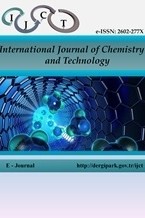Hydrogen generation by hydrolysis of ammonia borohydride using the Nano-Bimetallic catalyst
Hydrogen generation by hydrolysis of ammonia borohydride using the Nano-Bimetallic catalyst
Ammonia borane, Co-Cr-B, Hydrogen Nanocatalyst, Hydrolysis,
___
- 1. İzgi, M. S.; Şahin, Ö.; Erhan, O.; Horoz, S. Iğdır Üniv. Fen Bil. Ens. Derg. 2017, 7 (4), 151-160.
- 2. Christian, P. A.; Eylem, C.; Nanjundaswamy, K. S.; Zhang, F.; Wang, Google Patents: 2007.
- 3. Tutar, F.; Mehmet, E., Uluslararası İktisadi ve İdari İncelemeler Dergisi 2011, (6), 61-67.
- 4. Şahin, Ö.; İzgi, M. S.; Onat, E.; Saka, C. Int. J. of Hyd. Energy, 2016, 41 (4), 2539-2546.
- 5. Fernandes, R.; Patel, N.; Miotello, A, Applied Catalysis B: Environ. 2009, 92 (1-2), 68-74.
- 6. Ding, X.-L.; Yuan, X.; Jia, C.; Ma, Z.-F. Int. J. of Hyd. Energy. 2010, 35 (20), 11077-11084.
- 7. Huynh, K.; Napolitano, K.; Wang, R.; Jessop, P. G.; Davis, B. R. Int. J of Hyd. Energy. 2013, 38 (14), 5775-5782.
- 8. Su, C.-C.; Lu, M.-C.; Wang, S.-L.; Huang, Y.-H. RSC advances. 2012, 2 (5), 2073-2079.
- 9. İzgi, M. S.; Şahin, Ö.; Saka. Int. J. of Hyd. Energy 2016, 41 (3), 1600-1608.
- 10. İzgi, M. S. Energy. Sour., Part A: Reco. Utilization and En. Effect 2016, 38 (17), 2590-2597.
- 11. Sait Izgi, M.; Şahin, Ö.; Saka, C. Materials and Manufac. Processes 2019, 34 (14), 1620-1626.
- 12. Kazici, H. Ç.; Yildiz, F.; İzgi, M. S.; Ulaş, B.; Kivrak, H. Int. J. of Hydrogen Energy 2019, 44 (21), 10561-10572.
- 13. Jeong, S.; Kim, R.; Cho, E.; Kim, H.-J.; Nam, S.-W.; Oh, I.-H.; Hong, S.-A.; Kim, S. H. Journal of Power Sources 2005, 144 (1), 129-134.
- 14. Salinas-Torres, D.; Navlani-García, M.; Kuwahara, Y.; Mori, K.; Yamashita, H. Catalysis Today 2019, 324, 90-96.
- 15. Jia, H.; Chen, X.; Song, X.; Zheng, X.; Guan, X.; Liu, P. Int. J. of Energy Research 2019, 43 (1), 535-543.
- 16. İzgi, M. S.; Baytar, O.; Şahin, Ö.; Kazıcı, H. Ç, Int. J. of Hydrogen Energy 2020. doi.org/10.1016/j.ijhydene.2020.04.034
- 17. Rakap, M., Renewable Energy 2020, 155, 1222-1230.
- Yayın Aralığı: Yılda 2 Sayı
- Başlangıç: 2017
- Yayıncı: İbrahim DEMİRTAŞ
Antifungal effect of some essential oil combinations
Esvet AKBAŞ, Murat OKAY, Erdem ERGAN, Begüm Çağla AKBAŞ
Mehmet Şakir ECE, Sinan KUTLUAY, Ömer ŞAHİN
Burçin TÜRKMENOĞLU, Yahya GÜZEL
The activity of ceria supported complex in hydrogen generation
Hydrogen generation by hydrolysis of ammonia borohydride using the Nano-Bimetallic catalyst
Bedriye Seda KURŞUN AKTAR, Ayşe ŞAHİN YAĞLIOĞLU, Emine Elçin ORUÇ-EMRE
